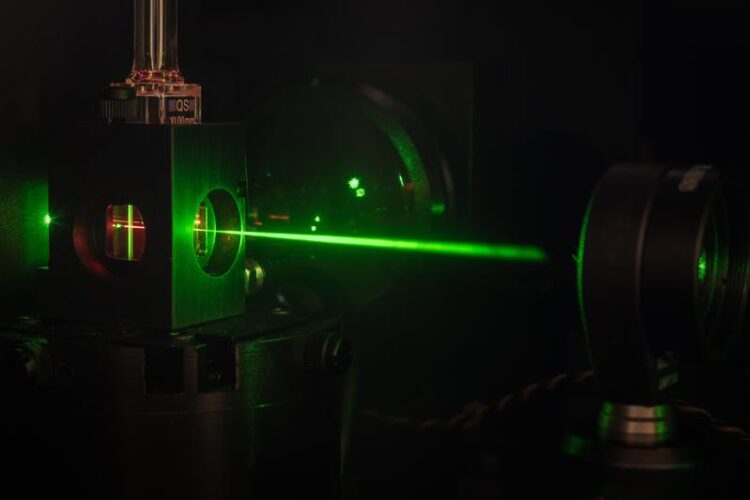Novel approach to the storage of solar energy

Messaufbau für die Untersuchung der photophysikalischen Eigenschaften, z.B. von Kupfer(I)-Komplexen
Martin Schulz
Using the energy from the sun as efficiently as nature does and converting it into chemical energy could drastically reduce global CO2 emissions. A research team from the Leibniz Institute of Photonic Technology (Leibniz IPHT) and the Friedrich Schiller University Jena has now come one step closer to this vision.
The researchers have developed a chemical system that collects light energy and stores it on a molecule for at least 14 hours. Based on a copper complex, their system thus decouples photochemical processes from the day-night cycle — thus overcoming a barrier that previously made solar-powered photochemistry unsuitable for continuous industrial production processes.
Nature has already solved the problem: In photosynthesis, plants use sunlight to convert carbon dioxide into chemical compounds — in such a way that the solar energy stored in chemical bonds is also available when it is dark. Researchers are attempting to imitate this process using nature as a model; however, solar-driven photochemistry has so far only worked in bright light due to a lack of suitable storage facilities.
Molecular approach enables light-driven photochemistry in the dark for the first time
The research team from Leibniz IPHT and the University of Jena is now presenting a molecular approach to the storage of solar energy, which for the first time makes it possible to decouple photochemical reactions from the day-night cycle and allow them to take place independently of daylight. In contrast to previous approaches, which are based on solid state materials, the researchers generate reactive photoredox equivalents on a small molecule. This enables them not only to store the light energy for a previously unattained duration of at least 14 hours, but also to regenerate it when needed. The researchers published their results in the “Journal of the American Chemical Society”.
“The dependence on brightness and darkness has so far been a major hurdle when it comes to using solar-powered photochemistry for continuous industrial production processes,” explains main author Dr. Martin Schulz, who conducts research at the University of Jena and Leibniz IPHT. “We assume that our results will open up new possibilities to research systems for the conversion and storage of solar energy as well as for photo(redox)catalysis“.
High charging capacity even after several cycles
In the chemical system developed by the Jena researchers within the Collaborative Research Center “CataLight”, the photosensitizer and the charge storage unit are located on the same small molecule. This eliminates the need for intermolecular charge transfer between a separate sensitizer and a charge storage unit. The system retains three quarters of its charge capacity even after four cycles.
The researchers use a copper complex and thus a molecule based on a readily available metal, whereas previous approaches used rare and expensive precious metals such as ruthenium. The doubly reduced copper complex can be stored after photochemical charging and used as a reagent in dark reactions such as the reduction of oxygen.
The Jena researchers developed the approach together with partners from the University of Ulm, the Leibniz Institute for Solid State and Materials Research Dresden and Dublin City University. In the Collaborative Research Center “CataLight” (“Light-driven Molecular Catalysts in Hierarchically Structured Materials — Synthesis and Mechanistic Studies”) teams of scientists from the Universities of Jena and Ulm are researching sustainable energy converters modeled on nature.
Wissenschaftliche Ansprechpartner:
Dr. Martin Schulz
Leibniz Institute of Photonic Technology & Friedrich Schiller University Jena
martin.schulz.1(a)uni-jena.de
Originalpublikation:
Martin Schulz, Nina Hagmeyer, Frerk Wehmeyer, et al. (2020), Photoinduced Charge Accumulation and Prolonged Multielectron Storage for the Separation of Light and Dark Reaction. J. Am. Chem. Soc. 2020, August 22, 2020. https://doi.org/10.1021/jacs.0c03779
Weitere Informationen:
https://www.leibniz-ipht.de/en/news/latest-news/detail/jenaer-forschungsteam-ste…
Media Contact
All latest news from the category: Physics and Astronomy
This area deals with the fundamental laws and building blocks of nature and how they interact, the properties and the behavior of matter, and research into space and time and their structures.
innovations-report provides in-depth reports and articles on subjects such as astrophysics, laser technologies, nuclear, quantum, particle and solid-state physics, nanotechnologies, planetary research and findings (Mars, Venus) and developments related to the Hubble Telescope.
Newest articles

Parallel Paths: Understanding Malaria Resistance in Chimpanzees and Humans
The closest relatives of humans adapt genetically to habitats and infections Survival of the Fittest: Genetic Adaptations Uncovered in Chimpanzees Görlitz, 10.01.2025. Chimpanzees have genetic adaptations that help them survive…

You are What You Eat—Stanford Study Links Fiber to Anti-Cancer Gene Modulation
The Fiber Gap: A Growing Concern in American Diets Fiber is well known to be an important part of a healthy diet, yet less than 10% of Americans eat the minimum recommended…

Trust Your Gut—RNA-Protein Discovery for Better Immunity
HIRI researchers uncover control mechanisms of polysaccharide utilization in Bacteroides thetaiotaomicron. Researchers at the Helmholtz Institute for RNA-based Infection Research (HIRI) and the Julius-Maximilians-Universität (JMU) in Würzburg have identified a…



